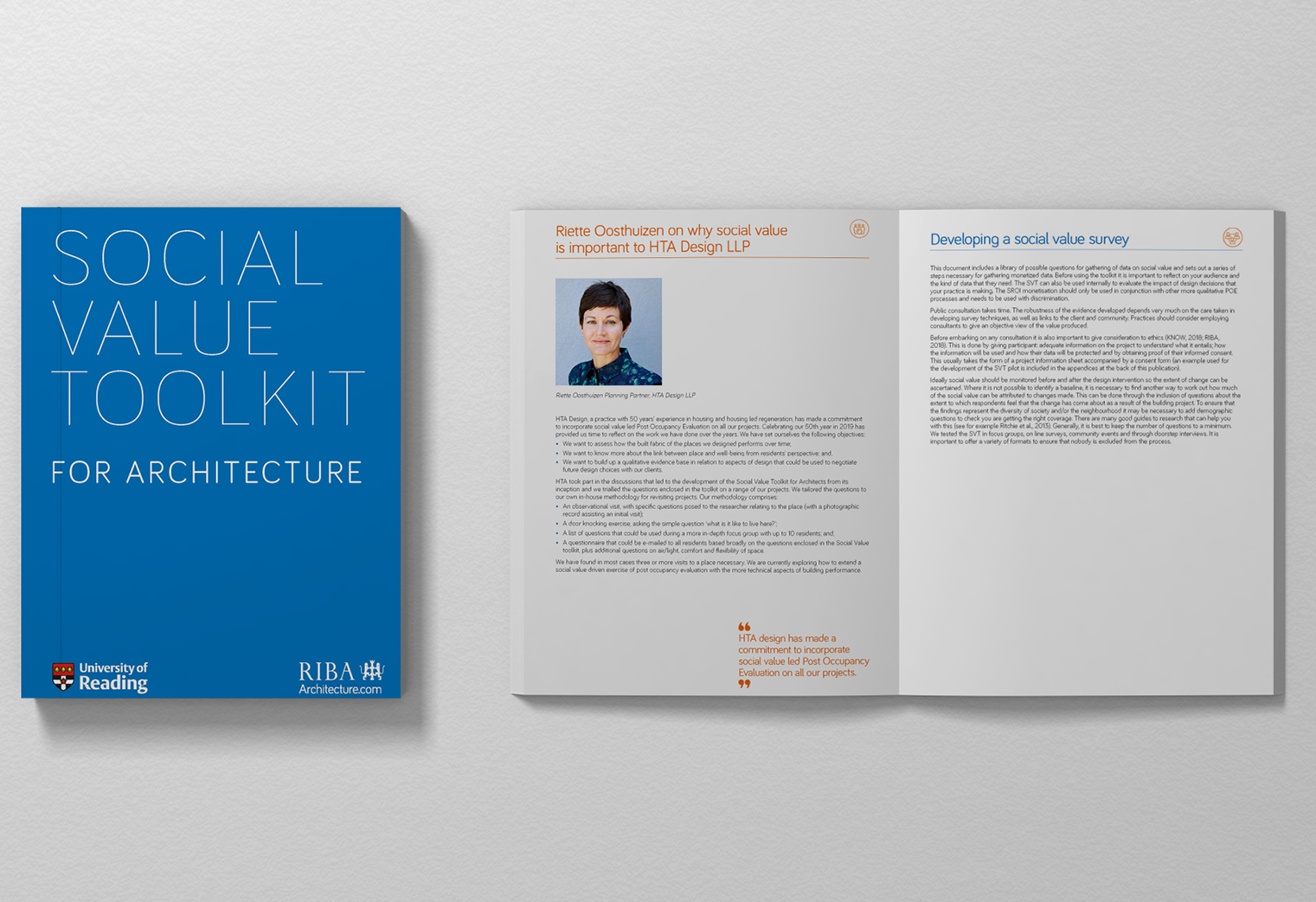Social Value Toolkit for Architecture
Social Value Toolkit for Architecture
Guidance from the RIBA and the University of Reading on evaluating the social value impact on people and communities delivered by a project.
Ben Derbyshire, Foreward
Happily, central government has elevated the importance of design quality, and ‘beauty’ has lately become an aspiration declared by Secretaries of State for Housing, Communities and Local Government. Design quality is of course to be found in more than just the appearance of buildings – it relates to the impact on people’s lives of buildings and places, in design, construction and management over the years – good or bad. The architect’s role in this is fundamental.
The Social Value Act 2012 was never specifically intended to apply to the design of places and buildings. But the act is indirectly influential in prescribing the societal benefits arising through development, as a result of government procurement provisions. In public procurement, architects increasingly come across the need to demonstrate Social Value on their projects – although the focus until now has been very much on the process of development; on, for example, the jobs created during construction. But our concern should be for long term outcomes of certain design decisions that deliver lasting human wellbeing.
Architects do little to obtain feedback on the outcomes of their work and are shockingly ignorant of the impact they have on communities. As a result, it is virtually impossible to predict or explain the positive societal impact of their contribution to buildings, homes and places.
Social value, as a rule, previously hasn’t been viewed as a return on real estate investment or as a measure of progress during different stages of a project. However, it would have significant impact if only it was better understood. Instead, economic viability has dominated planning negotiations and development outcomes; not always resulting in lasting quality or sustainable wider societal benefit. There has been a rather impoverished notion that Section 106 monies should be used to ‘mitigate the negative impacts of development’. However, the long term good (or not) deriving from development is not judged by the consumers of construction projects and neither is it sought or understood by developers and their consultants in any meaningful process of research and feedback.
But in a world where there is an increasing realisation that the funding streams for the provision of homes, the healthcare system and protecting the environment should be fundamentally aligned to ensure the best outcomes for long term sustainability. Accordingly, built environment professionals need to up their game in understanding their role in delivering predictably and positively on these important societal issues. What value can and do they add?
The Social Value Toolkit for Architecture has been developed to make it simple to demonstrate and evaluate the impact of design on people and communities, outcomes that are increasingly considered as social value benefits in public policy and procurement. This RIBA source book understands social value to be much broader than the social capital of a place but rather the holistic social, environmental and economic benefits to society.
The toolkit presents a library of questions for practitioners to use in the duration of projects and to revisit them once built. The questions are based on assessing existing research on key indicators of wellbeing. It argues that the social value of architecture is revealed in the extent to which it fosters positive emotions. This can be through connections with nature, offering opportunities for an active lifestyle, connecting people and the environment in appropriate ways, providing freedom and flexibility to pursue different lifestyles without conflict and the ability to participate.
I am delighted to see RIBA launch this toolkit for architects to use on their projects. It is open source and presents a library of ideas that can be individually tailored to assess the impact of projects on people and increase shared learning in a wide range of circumstances.
Riette Oosthuizen on why social value is important to HTA Design LLP
HTA Design, a practice with 50 years’ experience in housing and housing led regeneration, has made a commitment to incorporate social value led Post Occupancy Evaluation on all our projects. Celebrating our 50th year in 2019 has provided us time to reflect on the work we have done over the years. We have set ourselves the following objectives:
• We want to assess how the built fabric of the places we designed performs over time;
• We want to know more about the link between place and well-being from residents’ perspective; and,
• We want to build up a qualitative evidence base in relation to aspects of design that could be used to negotiate future design choices with our clients.
HTA took part in the discussions that led to the development of the Social Value Toolkit for Architects from its inception and we trialled the questions enclosed in the toolkit on a range of our projects. We tailored the questions to our own in-house methodology for revisiting projects. Our methodology comprises:
• An observational visit, with specific questions posed to the researcher relating to the place (with a photographic record assisting an initial visit);
• A door knocking exercise, asking the simple question ‘what is it like to live here?’;
• A list of questions that could be used during a more in-depth focus group with up to 10 residents; and,
• A questionnaire that could be e-mailed to all residents based broadly on the questions enclosed in the Social Value toolkit, plus additional questions on air/light, comfort and flexibility of space.
We have found in most cases three or more visits to a place necessary. We are currently exploring how to extend a social value driven exercise of post occupancy evaluation with the more technical aspects of building performance.
Read full toolkit here










